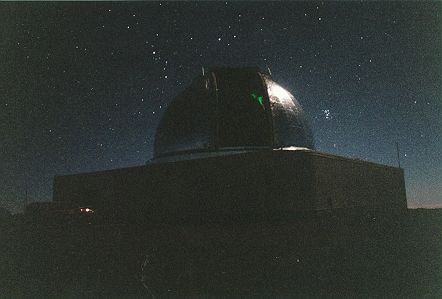

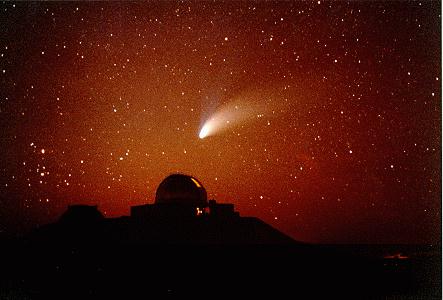 Big secret - the largest infrared telescope NASA operates isn't in Earth
orbit, though the air is pretty thin up there. The 3-meter Infrared Telescope
Facility was originally built to support the Voyager encounters of the
giant planets, and is still 50% devoted to solar-system studies.
If my experience in getting a project scheduled is any guide, this is the most
exclusive telescope I've ever used. The IRTF takes advantage of the high and
dry conditions at Mauna Kea, and they have now pushed its image quality far
beyond the initial "light-bucket" specifications. I've used it in a project
with Sam Pascarelle and Rogier Windhorst to observe our good friends in the
53W002 cluster at redshift z=2.4, employing the unique tunable narrowband
filter in the NSFCAM imager to trace redshifted H-alpha emission. We went
to all this trouble because, for galaxies at such high redshift, the
well-understood visible part of the spectrum reaches us in the infrared,
so these data can give us a more secure measurement of how rapidly these
young galaxies form stars than we can get from the ultraviolet radiation
now reaching us as visible light (which is what we used to find them from
HST data in the first place).
We also
sneaked in some
images of the nucleus of Comet Hale-Bopp and some of the
overlapping galaxies for my dust project. Funny, these days the IRTF really
looks like the runt of the mountaintop. Anyway, we've traced the H-alpha
emission from objects at z=2.4, as shown here,
for comparison with HST results on their (originally UV) Lyman-alpha emission.
The comparison can trace how much dust had formed in such young galaxies,
and together with HST NICMOS data, show what their chemistry and thus
star-formation history had been. These pictures show a 75-arcsecond
portion of the cluster first in the K band at 2.2 microns, and then
in the narrow filter including redshifted H-alpha emission. The circled
objects are known cluster members based on optical observations.
The three bright ones, which have active nuclei, are much brighter than
other object in the H-alpha image; more data are being added to check on fainter
ones, and see whether there are members too strongly affected by internal
dust to be obvious at shorter wavelengths. The east-west elongation of
the southernmost one (53W002 itself) is real, showing the aligned
ionized gas in the direction of the radio source, as also seen in
HST and Kitt Peak data on its Lyman-alpha emission and HST NICMOS
spectroscopy of its [O III] 5007-Angstrom line (which reaches us at
1.69 microns wavelength).
Big secret - the largest infrared telescope NASA operates isn't in Earth
orbit, though the air is pretty thin up there. The 3-meter Infrared Telescope
Facility was originally built to support the Voyager encounters of the
giant planets, and is still 50% devoted to solar-system studies.
If my experience in getting a project scheduled is any guide, this is the most
exclusive telescope I've ever used. The IRTF takes advantage of the high and
dry conditions at Mauna Kea, and they have now pushed its image quality far
beyond the initial "light-bucket" specifications. I've used it in a project
with Sam Pascarelle and Rogier Windhorst to observe our good friends in the
53W002 cluster at redshift z=2.4, employing the unique tunable narrowband
filter in the NSFCAM imager to trace redshifted H-alpha emission. We went
to all this trouble because, for galaxies at such high redshift, the
well-understood visible part of the spectrum reaches us in the infrared,
so these data can give us a more secure measurement of how rapidly these
young galaxies form stars than we can get from the ultraviolet radiation
now reaching us as visible light (which is what we used to find them from
HST data in the first place).
We also
sneaked in some
images of the nucleus of Comet Hale-Bopp and some of the
overlapping galaxies for my dust project. Funny, these days the IRTF really
looks like the runt of the mountaintop. Anyway, we've traced the H-alpha
emission from objects at z=2.4, as shown here,
for comparison with HST results on their (originally UV) Lyman-alpha emission.
The comparison can trace how much dust had formed in such young galaxies,
and together with HST NICMOS data, show what their chemistry and thus
star-formation history had been. These pictures show a 75-arcsecond
portion of the cluster first in the K band at 2.2 microns, and then
in the narrow filter including redshifted H-alpha emission. The circled
objects are known cluster members based on optical observations.
The three bright ones, which have active nuclei, are much brighter than
other object in the H-alpha image; more data are being added to check on fainter
ones, and see whether there are members too strongly affected by internal
dust to be obvious at shorter wavelengths. The east-west elongation of
the southernmost one (53W002 itself) is real, showing the aligned
ionized gas in the direction of the radio source, as also seen in
HST and Kitt Peak data on its Lyman-alpha emission and HST NICMOS
spectroscopy of its [O III] 5007-Angstrom line (which reaches us at
1.69 microns wavelength).
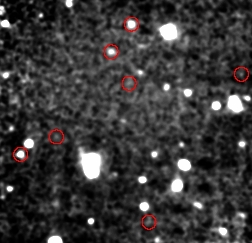 |
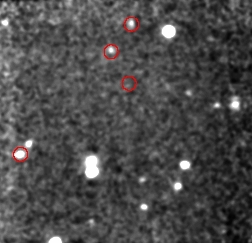 |
| Broad-band K image | Narrow-band redshifted H-alpha |
And a little more recent - the submillimeter-bright galaxy ELAIS N2 850.4 seen in Hα (at redshift z=2.4), from work with Ian Smail. This image helped show the role of a global wind in this luminous galaxy.
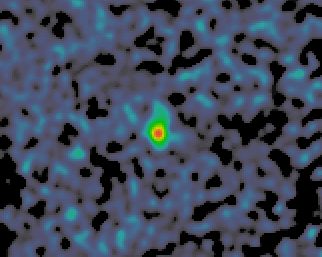
Last changes: 11/1999 © 1999